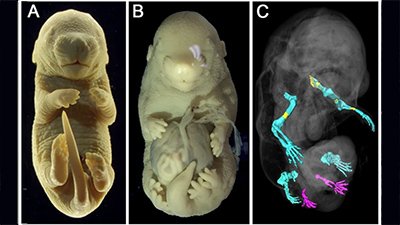A Fresh Look at Human-Chimp DNA Similarity
Often scientific reports or mainstream media claim 99% identical comparisons between human and chimp genomes. The number has been dropping in some circles recently, but is still on the order of 95+%. There is inherent bias in these calculations because significant lengths of DNA that are quite different between the two species are omitted from the results. A very simplified comparison would be comparing blue jeans (pardon the pun) with cut-off jeans. The fact that the legs are missing on one is discounted and only the upper portion is compared, with particular emphasis on the comparison of the rivets, buttons, pockets, topstitching, and zipper, but not much comparison on the brand, color, or the quality of the fabric. In a similar way, gaps or missing portions (like the missing legs on the cut-off jeans) and regulatory portions (like the fabric) from one are typically ignored, and only gene-rich segments of DNA are analyzed (like pockets, buttons, and rivets). Taking all those things into account, in 2012 creationist scientists Drs. Tomkins and Bergman came up with an overall similarity of around 81%—quite a difference!1 Other researchers have come up with even lower percent similarity, averaging around 70%.2 In 2013, Tomkins tested alignment of each chimpanzee chromosome against its human counterpart and only found an overall genome similarity of about 70%, which was published in Answers Research Journal.

Figure 1. A schematic showing the alignment of DNA bases used for comparison between humans and chimps. Note that considerably longer regions to the left and right of aligned regions that do not show similarities and small regions within aligned regions are often omitted from calculations of overall similarity, artificially inflating this number. Image reproduced from Tomkins and Bergman, “Genomic Monkey Business . . . ” http://creation.com/human-chimp-dna-similarity-re-evaluated.
BLASTN Away at Percent Similarity
BLASTN, an online program (an algorithm, actually) that many scientists use to compare the sequence of DNA bases comprising the genomes of organisms, occasionally gets updated as any software. In 2014, a programmer reported a bug in BLASTN to Dr. Tomkins. At that point, Dr. Tomkins noticed that the most recent versions seemed to be omitting many results that weren’t at least 98% similar to the target human base sequences. Dr. Tomkins decided to investigate using six versions of this algorithm, including the recent versions in question. Additionally, he used two other common algorithms for DNA comparison, Nucmer and LASTZ.3
Both the earlier version of BLASTN and Nucmer returned an average of 88% identity overall between the human and chimp compared chromosomes. LASTZ returned a surprisingly lower average of only 73% matching. Dr. Tomkins suggested more research into the LASTZ program to investigate this.
Taking the more reliable results provided by the earlier BLASTN version corroborated by the whole chromosome alignments of Nucmer obtained in this study, it is likely that the 88% similarity number is considerably more accurate than other methods to date. Additionally, studies show that chimpanzees have a genome size about 8% larger than humans, so “the actual genome similarity with human, even using the high end estimate of 88% for just the alignable regions, is realistically only about 80% or less when the cytogenetic data is taken into account,” according to the latest Tomkins study.
Why Are Evolutionists’ Numbers So High?
Chimpanzee sequences were assembled using the human genome as a framework and the program’s parameters omitted non-alignable sequences.
The premier publication comparing the human and chimpanzee genome was from the Chimpanzee Genome Sequencing Consortium in 2005.4 But the methodology was biased: chimpanzee sequences were assembled using the human genome as a framework and the program’s parameters omitted non-alignable sequence. So if you assume humans and chimps are related, match up the DNA sequences based solely on evolutionary bias, match only the most similar regions, and ignore the rest (consider that humans have 23 chromosome pairs and chimps have 24 pairs), you’ll come up with some pretty high similarity, too! A 2012 Journal of Creation (JoC)5 paper sheds some light on some of these earlier studies, reporting bias beginning even in the selection of sequences to compare. One study even admitted to some “quality control,” where one-third of the chimp sequences were thrown out before the comparison because they didn’t have enough of a human match. In other early studies, unintentional human contamination aside, “human sequence contamination is . . . added to fill in putative missing chimp sequences.”6
Is the Test Tube 80% Full or 20% Empty?
Looking at Tomkins’ lower percentages may give some a sigh of relief, but the fact that we’re even 80% similar is disconcerting to many, or perhaps causes evolutionists to still assert common ancestry. But step outside either paradigm for a moment and consider how all plants and animals must function together, sharing organic material and using the same inorganic resources. Life simply wouldn’t work on this planet without some degree of sameness. The biologic functions that we all share involve the same mechanics: intake, metabolism, mobility, output, and so on. While there are numerous ways this is accomplished throughout the animal and plant kingdom, there are still these basic functions on even a cellular level, as well as a “macroorganism” and environmental level.
Looking at the numbers of actual bases puts the problem in even clearer light.
And consider what that 20% difference means. There are roughly 20,000 protein-coding genes in the human genome. That would be a difference of roughly 4,000 proteins. And given that we expect there to be some commonality in proteins, for example, digestive enzymes, that 80% should be looking a bit less impressive. And keep in mind that less than 5% of the human genome contains protein-coding sequences. Looking at the numbers of actual bases puts the problem in even clearer light. Conservatively, if the human genome is over 3,000,000,000 base pairs, and the difference is 20%, that is 600,000,000 base pair differences just between humans and chimps! That adds up to a lot of evolution when you consider all the organisms in the kingdoms of life—that couldn’t happen even in 6 billion years, especially considering the changes that are kept have to be viable, too!
God created one world and made it a beautiful place for his creations to live together and thrive. Why wouldn’t He use good and common designs? Those things that aren’t good are a result of the Curse on creation that God pronounced in response to man’s desire to try to be a god himself in the Garden of Eden. And still we are looking for a way to not give God the glory He deserves for His creation, because we’re back to our jean analogy with evolutionists only lining up rivets, pockets, and zippers and ignoring the rest, trying to make it seem simpler for a godless process. We will agree with them on the fact that the “jeans” all have one “designer” and contain similar materials and functional designs. But the Bible-believer’s designer is the God of the Bible, who created all things after their kind and pronounced His creation “very good” in Genesis 1. Consider the beauty, diversity, and complexity of creation and meditate upon Job 38–41. God is worthy.
Footnotes
- Jeffrey Tomkins and Jerry Bergman, “Genomic Monkey Business—Estimates of Nearly Identical Human-Chimp DNA Similarity Re-evaluated Using Omitted Data,” Creation Ministries International, accessed December 16, 2015, http://creation.com/human-chimp-dna-similarity-re-evaluated.
- Richard Buggs, “Chimpanzee?” Reformatorisch Dagblad, October 10, 2008, http://www.refdag.nl/.chimpanzee_1_282611; “An Automatic Comparison of the Human and Chimpanzee Genomes,” Progetto Cosmo, accessed December 16, 2015, http://progettocosmo.altervista.org/index.php?option=content&task=view&id=130; Tomkins, “Comprehensive Analysis of Chimpanzee and Human Chromosomes Reveals Average DNA Similarity of 70%,” Answers Research Journal 6 (2013): 63–69, https://answersingenesis.org/answers/research-journal/v6/comprehensive-analysis-of-chimpanzee-and-human-chromosomes/; among others.
- To see the details of how these algorithms function and the parameters used in these experiments, please see the 2015 Tomkins ARJ paper.
- The Chimpanzee Sequencing Analysis Consortium, “Initial Sequence of the Chimpanzee Genome and Comparison with the Human Genome,” Nature 437, no. 7055 (2005): 69–87, doi: 10.1038/nature04072.
- Tomkins and Bergman, “Genomic Monkey Business . . . ”
- Ibid.
Recommended Resources

Answers in Genesis is an apologetics ministry, dedicated to helping Christians defend their faith and proclaim the good news of Jesus Christ.
- Customer Service 800.778.3390
- © 2024 Answers in Genesis







